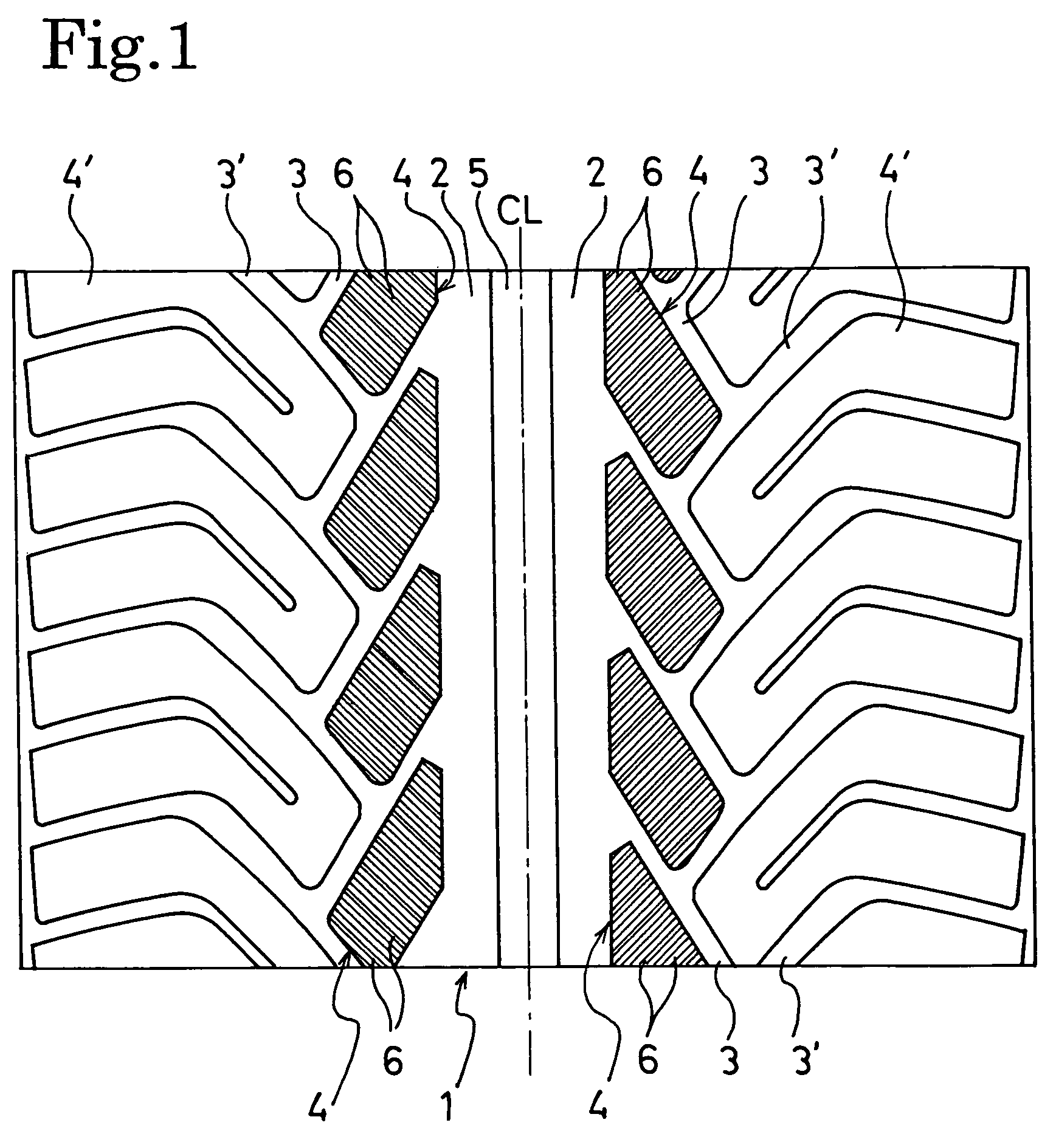Pneumatic tire with tread having fine grooves
a technology of pneumatic tires and grooves, which is applied in the field of pneumatic tires, can solve the problems of difficult general drivers to determine whether or not the tire can maximize the potential, the tread surface wear of the pneumatic tire is not uniform over the entire ground contact surface, and the pneumatic tire does not sufficiently maximize the potential. to achieve the effect of maximizing the potential
- Summary
- Abstract
- Description
- Claims
- Application Information
AI Technical Summary
Benefits of technology
Problems solved by technology
Method used
Image
Examples
embodiment 1
A pneumatic tire with the following configuration was prepared. Specifically, fine grooves were formed in the entire ground-contacting region of land portions in the tread part to be symmetrical about the equator of the tire, while the land portions had a tread pattern symmetrical about the equator of the tire. The inclination angle of each fine groove relative to the circumferential direction of the tire was 50°. The depth and the width of each fine groove were 0.4 mm and 0.4 mm, respectively. The pitch of the fine grooves was 1.3 mm.
The prepared pneumatic tire was broken in, in the above-described manner, to be evaluated in terms of the state of wear of the land portions of the tread part. The result of the evaluation is shown in Table 1.
TABLE 1EmbodimentEmbodimentEmbodimentEmbodimentEmbodimentEmbodimentEmbodimentComparativeComparative1234567Example 1Example 2Pattern of LandSymmetricalSymmetricalSymmetricalSymmetricalSymmetricalSymmetricalDirectionalSymmetricalSymmetricalPortionsa...
embodiment 2
A pneumatic tire was prepared in the same manner as in the case of Embodiment 1, except the following configuration. Specifically, the pneumatic tire of Embodiment 2 had the tread part with a shape symmetrical about the equator of the tire. Concurrently, land portions were arranged on the left and right sides of the equator to be displaced from each other in the circumferential direction by approximately 25% of the pitch in the tread part. Then, the same break-in run and evaluation as those in the case of Embodiment 1 were performed on the pneumatic tire of Embodiment 2. The result of the evaluation is shown in Table 1. It was demonstrated that the pneumatic tire of Embodiment 2 was the same as that of Embodiment 1 in terms of, the uniformity of wear of the land portions of the tread part, the visibility of the wear-out of the fine grooves, and the like. Moreover, in addition, a reduction in running noise was obtained.
embodiment 3
A pneumatic tire was prepared in the same manner as in the case of Embodiment 1, except the following configuration. Specifically, the pneumatic tire of Embodiment 3 had the same shape of the tread part as that of Embodiment 2. Concurrently, fine grooves were formed to be inclined, at 45° on the left side (on the inner side at the time when the tire was installed in the vehicle) of the equator of the tire, and at 60° on the right side (on the outer side at the time when the tire was installed in the vehicle) thereof. Then, the same break-in run and evaluation as those in the case of Embodiment 1 were performed on the pneumatic tire of Embodiment 3. The result of the evaluation is shown in Table 1.
PUM
 Login to View More
Login to View More Abstract
Description
Claims
Application Information
 Login to View More
Login to View More - R&D
- Intellectual Property
- Life Sciences
- Materials
- Tech Scout
- Unparalleled Data Quality
- Higher Quality Content
- 60% Fewer Hallucinations
Browse by: Latest US Patents, China's latest patents, Technical Efficacy Thesaurus, Application Domain, Technology Topic, Popular Technical Reports.
© 2025 PatSnap. All rights reserved.Legal|Privacy policy|Modern Slavery Act Transparency Statement|Sitemap|About US| Contact US: help@patsnap.com


